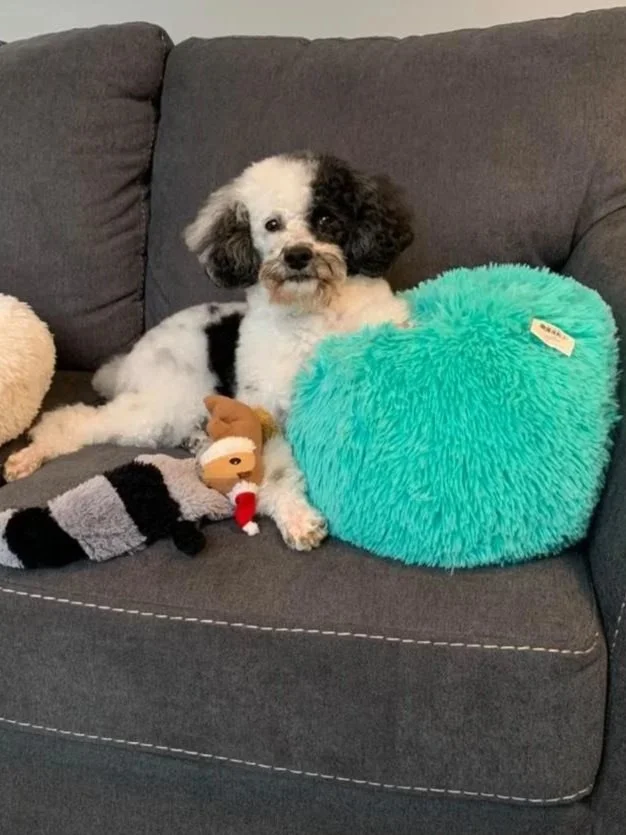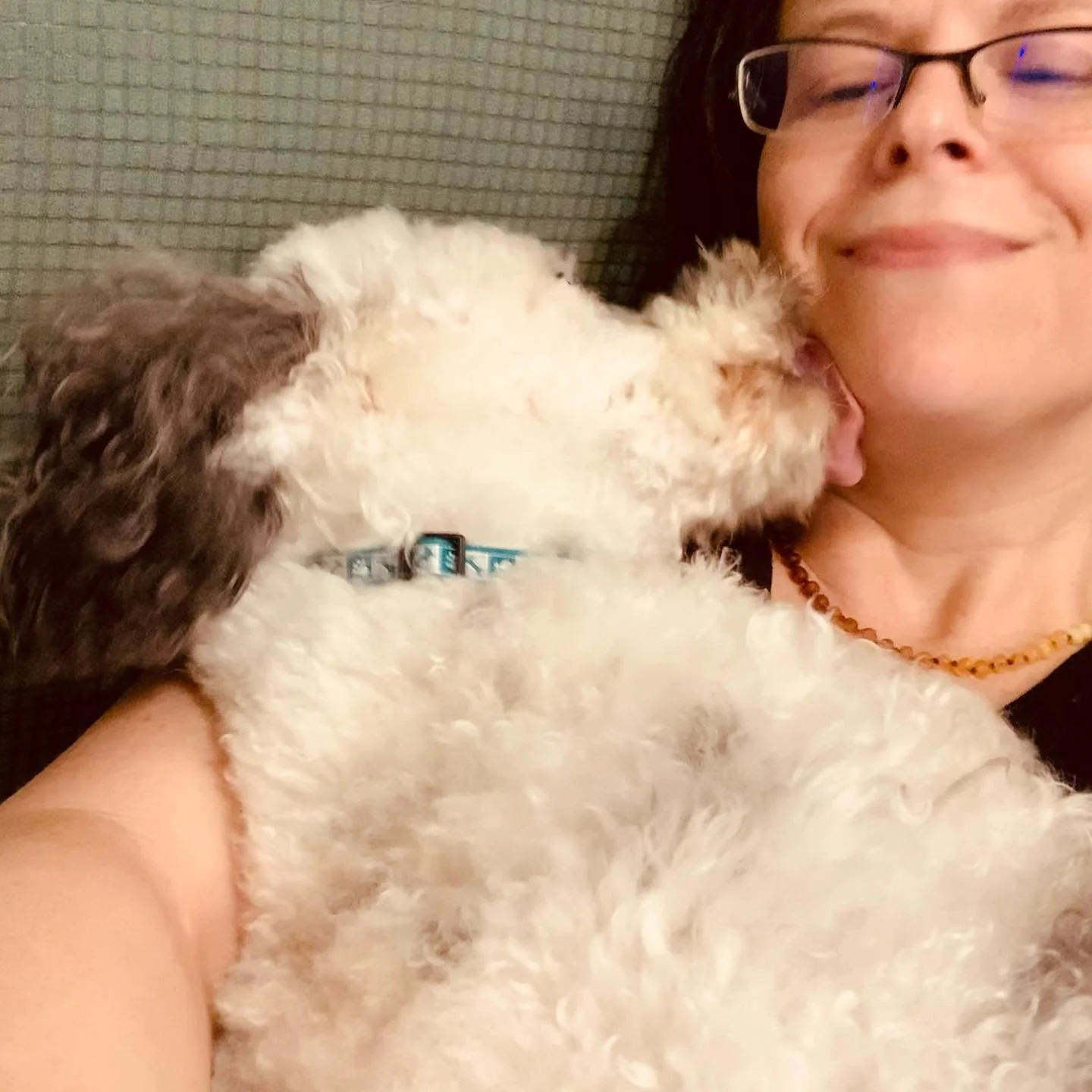My Dog Has Prostate Cancer: What I’ve Learned About Care, Coping, and Treatment Options
It’s been about a month since we learned that “Dogtor Murphy,” my therapy dog, has prostate cancer. One of the ways I cope with difficult times is by searching, researching, and gathering information. Because my practice is called Therapy for Pet People, I often sit with clients who are grieving or anticipating the loss of a beloved animal. Now, as I walk through this with Murphy, I find myself on both sides of the experience, holding space for others while also navigating my own. That’s part of why I feel called to share what I’m learning here, in hopes it might bring some clarity or comfort to anyone else going through something similar.
This blog is focused on the practical and medical information I’ve learned so far. I’m also in the process of writing about the emotional side of this journey, but I’m not quite ready to share that piece yet. This information was obtained not only from our oncologist but also from Renée Michael (“Roscoe’s Mom”), who generously shared so much valuable knowledge. You can find her website here: Roscoe’s Cancer Journey and Treats.
🎥 Video: Roscoe’s Mom discusses her experience with her dog
There is also a wonderful community resource: the Dogs with Prostate Cancer – Support Group on Facebook, which has been very helpful.
Disclaimer: I want to be clear that this blog isn’t meant as medical advice. Every dog’s situation is different, so please check with your vet about what’s best for your pup.
Getting the Diagnosis
Like most people, the way we found out had nothing to do with prostate cancer. Murphy has had seizures on and off for the last five years, usually just a few times a year. After he had one, I decided to bring him in just to double-check things. Almost in passing, I mentioned to the vet that he’d been straining a little when he pooped. I figured he was just a bit constipated, probably from us switching his dog food. Honestly, I hadn’t been concerned about it in the slightest.
Rectal Exam
When the vet did a rectal exam to check why he was straining, they explained it was a quick way to feel for anything unusual with his prostate. To my surprise, the vet told me right away that they could actually feel a distinct bump. Hearing that was scary and overwhelming in the moment, and it was the start of us realizing we needed to do more testing to find out what was going on.
Ultrasound
The ultrasound was the next step after the rectal exam, and it gave us a much clearer picture of what might be happening with Murphy’s prostate. During the scan, she found a 1.76 cm size mass on the prostate. While that was concerning, it didn’t tell us exactly what the mass was.
Cytology Test
The next step was the cytologist test. This meant collecting cells from his prostate through a urine sample and sending them off to a pathologist to look at under the microscope. The report came back showing “degenerate epithelial cells, concerning for necrotic neoplasia,” which is a technical way of saying there were changes in the cells that strongly suggested cancer.
BRAF Test
The BRAF test is a newer tool vets use to help diagnose certain cancers in dogs, especially prostate and bladder cancer. What makes it so helpful is that it’s non-invasive, the test is usually done on a urine sample instead of needing a biopsy. The lab looks for a specific gene change that’s commonly found in these types of tumors. If the test comes back positive, it’s very likely your dog has cancer. If it’s negative, that doesn’t always mean your dog is in the clear, but it does give your vet more information to go on alongside other tests.
What is the BRAF test
Everyday Challenges of Prostate Cancer
When we went to collect Murphy’s urine for his urinalysis, I was struck by how little output there actually was. I was used to him peeing several times when he went out and being “empty,” so at first I didn’t think much of it. Once I paid closer attention, I realized the bigger issue than I had been aware of.
Looking back, there were a few subtle signs I had missed. Dogs with prostate cancer can develop urination difficulties because the tumor presses against or blocks the urethra. Some of the things you might notice include:
Straining to urinate – they may squat or lift their leg for a long time but only a small amount comes out.
Frequent trips outside – they act like they need to go urgently, but produce very little each time.
Discomfort while peeing – whining, licking, or restlessness during or after urination.
Blood in the urine – sometimes only a tinge, other times more obvious.
Accidents in the house – not because of training issues, but because the bladder isn’t fully emptying.
For Murphy, the low urine output and the fact that he wasn’t drinking much were the biggest red flags. Once I dug into some research, I came across several articles explaining that dogs with prostate cancer often struggle with hydration, partly from drinking less, partly from straining to urinate but not fully emptying their bladder. Since this can sneak up on you, I wanted to share a few of the hydration tips I found in hopes they might help you, too.
We tried snack water but Murphy was having none of it. Since we were already feeding him Farmer’s Dog food, I started adding extra water to it. At first, I was giving him just two larger meals, but he would often vomit because he got too full from the added water. That’s when I switched to feeding him four smaller meals a day instead. It not only kept him from throwing up, but it also helped spread out the hydration more evenly throughout the day.
UTI’s
Another thing I learned along the way is that because of the tumor pressing on the urinary tract, dogs with prostate cancer are more prone to recurrent urinary tract infections (UTIs). It’s something important to keep an eye out for, signs can include straining to urinate, frequent accidents, blood in the urine, or just a change in their normal bathroom habits. Murphy has responded really well to antibiotics when he’s had infections, but our vet also suggested adding a cranberry supplement to help with prevention. We went with the Zesty Paws Cranberry Bladder Bites but there are other brands out there. You can even use fresh or frozen cranberries. Talk to your vet for guidance on amount and frequency.
The oncologist also shared something that really stuck with me, what can be especially hard with prostate cancer is that, for a long time, your dog may still be very much himself. Murphy still has his personality, his appetite, and his love for being with us. But eventually, the tumor can grow to the point where he is no longer able to urinate on his own, and that’s often the point when quality of life becomes most impacted. You can find more information on the impact of hydration issues and how to tell if your dog is dehydrated in this article: Hydrating Dogs with Cancer and Managing Complications.
Pooping Issues
Another symptom we noticed early on was that Murphy would strain when he pooped. At first, I didn’t think much of it because he was still going, it just seemed like he sat there a bit longer before and after. As the tumor grows, though, it can cause more issues with bowel movements. This is separate from any side effects that may come from medications. One old tried-and-true option for constipation is pumpkin, and probiotics can sometimes help as well. Some holistic vets may also recommend different herbs to help manage these issues. It’s important to know that this isn’t something that’s likely to get “better” it’s more about finding ways to manage it so your dog can stay as comfortable as possible.
Treatment Options for Canine Prostate Cancer
NSAIDS
NSAIDs are one of the main medications vets often use when a dog has prostate cancer. I was told that they don’t just help with pain and inflammation, in some cases, they can actually slow the growth of the tumor by blocking certain cancer receptors. The tricky part is that they can also be hard on the stomach, kidneys, or liver, so it’s important to work closely with your vet to find one your dog can tolerate. In Murphy’s case, we’ve had to do some trial and error, but the potential benefits may make it worth exploring with your vet.
Examples of commonly used NSAIDs include carprofen (also known as Rimadyl, Vetprofen, Novox, and others), piroxicam, Metacam (also known as meloxicam), and Previcox. Galliprant is less commonly used for cancer patients since it works a little differently and doesn’t seem to have the same effect on cancer receptors.
We were told, and it was also listed on the bottle, that if Murphy vomited, developed diarrhea, or stopped eating, we should stop the medication immediately and contact the vet. Unfortunately, he did experience these side effects, so we switched him to a new medication along with probiotics, which he seemed to tolerate better.
The oncologist also explained that NSAIDs can’t be given alongside steroids, and regular bloodwork (usually every three months, or sooner if there are concerns) is important to check for any issues with the kidneys or liver. In terms of outcomes, the average survival time with NSAIDs alone is about six months for bladder tumors, and two to three months for prostate tumors. That said, there are reports suggesting prostate tumors sometimes respond more like bladder tumors and may have a longer survival time, possibly up to a year in some cases.
Overall, NSAIDs are often the starting point for treatment because they can both improve comfort and, in some cases, help slow things down. For us, even though Murphy had side effects, finding one he could tolerate felt like a worthwhile step to give him the best quality of life possible.
For more information about each of them, you can look these medications individually on this website https://www.petmd.com/pet-medication
To help protect the stomach and help them tolerate the NSAIDS probiotics and other medications can be given.
Here is a list of probiotics that may be helpful: Visbiome (order directly from the company since it must be protected from heat), Proviable (available on Amazon, Chewy, and other retailers), RxBiotic (available on Amazon but only from the verified H3 store that ships from the Rx Vitamins warehouse), and Saccharomyces boulardii probiotics such as Four Leaf Rover or AnimalBiome for Dogs (helpful for controlling diarrhea and protecting the gut). Your vet may have a preference to which works better. We tried Visbiome that was prescribed by the vet but also tried Proviable.
Other options that may help with stomach issues include Omeprazole (Prilosec), an antacid that reduces stomach acid; Alimend K9, a supplement; and Misoprostol, a prescription medication. There are also herbs that may be helpful, like fennel seed tea, a natural option that can aid digestion, but it’s important to consult with a holistic vet before giving because it may interact with other medications or medical conditions your pup has.
Chemotherapy for Dogs with Prostate Cancer
One of the treatment options we were told about was chemotherapy. I want to be clear that I’m not a vet, this is just the information I was given from the oncologist as a pet owner exploring what might help Murphy. Chemotherapy can sometimes be used to help slow down prostate cancer, though from what I was told, it doesn’t tend to be as effective as it is with certain other types of cancer. It usually involves oral or injectable medications given on a schedule set by a veterinary oncologist. The goal isn’t a cure but rather trying to slow the cancer’s progression and keep a pup comfortable for as long as possible.
In Murphy’s case, he already had preexisting liver and kidney issues, and because chemotherapy can put additional stress on those organs, we made the decision not to move forward with it. Every dog’s situation is different, and that was the choice that felt right for us.
From the vet’s explanation, chemotherapy for prostate or bladder cancers usually involves treatments given every two to three weeks, either through IV or oral medications. The initial drug is often vinblastine, which costs around $500 per dose. If that stops working or isn’t tolerated, there are “backup” drugs such as mitoxantrone (IV every 2–3 weeks, about $800–$1,000 per dose), carboplatin (IV every 3 weeks, $500–$700 per dose), or an oral option called Palladia. This cycle can continue indefinitely until the cancer progresses or the side effects become too much. These were estimates that we were given by the oncologist in Houston, Texas in 2025, so I’m sure prices will vary depending on location and clinic.
The oncologist also shared some data on outcomes. For bladder tumors, chemotherapy combined with an NSAID (like piroxicam or carprofen) has a median survival time of 6–9 months, and sometimes longer if the cancer is caught early. However, for prostate carcinomas, research shows that chemotherapy combined with an NSAID doesn’t actually improve survival compared to NSAIDs alone. That was eye-opening for me as a pet owner, it really put into perspective how much the benefit depends on the type of tumor.
If you’re considering this route, it’s also worth knowing that pet insurance usually covers chemotherapy. However, I was told that in order for coverage to apply, many companies require a BRAF test (a genetic urine test that helps confirm prostate or bladder cancer) before they’ll approve treatment. That’s definitely something to ask about upfront.
Radiation Therapy for Dogs with Prostate Cancer
Another option that was explained to me was radiation therapy. Radiation uses targeted beams to shrink the cancer in the prostate. Because dogs can’t stay completely still during the procedure, they have to be placed under general anesthesia for each session, and owners aren’t allowed in the room. From what I learned, treatments are usually scheduled several times a week for a few weeks, depending on the plan. The actual radiation part doesn’t take long, but the repeated anesthesia and hospital visits can be tough for an older pup.
The cost was another factor I had to consider. I was told that a full course of treatment often ranges anywhere from $5,000 to $10,000 or more, depending on the clinic and number of sessions. For many families, that’s a big decision, not just financially, but also in terms of what their dog can realistically handle.
Radiation can also come with side effects, such as bladder or bowel irritation or general fatigue. That’s why many pet parents, myself included, weigh not only the potential benefits but also their dog’s comfort and quality of life before moving forward.
I also learned that there are different types of radiation therapy:
Definitive intent radiation therapy – Often used after surgery when the tumor wasn’t removed with clean margins. This approach aims for long-term control, with daily low doses of x-rays given Monday through Friday for 3–4 weeks. Side effects usually include skin irritation (similar to a sunburn), which is typically manageable.
Palliative radiation therapy – Used for tumors that can’t be removed, with the goal of easing pain and improving quality of life. It involves fewer treatments (usually 4–6 sessions), either weekly or on consecutive days, at higher doses per session. It tends to cause fewer short-term side effects, though late effects may occur months later.
Stereotactic radiation therapy (SRT) – A newer, more advanced option that delivers very high doses in just 1–5 treatments. The machine is designed to target the tumor more precisely, reducing exposure to healthy tissue. The goal is “durable palliation,” meaning longer-lasting relief compared to standard palliative radiation.
Even with radiation, it’s important to remember that no option is perfect. Tumor regrowth can still happen, and every family has to balance the potential benefits with the stress and risks of treatment.
Experimental Options: The Yale Vaccine Study
In addition to chemotherapy and radiation, I also learned about some newer, experimental approaches being studied. One of the most talked about is the Yale vaccine study for canine prostate cancer, which is exploring an immunotherapy approach designed to help a dog’s own immune system recognize and attack prostate tumor cells. Instead of relying on chemotherapy or radiation, the vaccine aims to slow tumor growth and improve survival by training the immune system to target cancer markers. Early research suggests it may be a promising option for dogs who can’t tolerate traditional treatments, though it is still experimental and generally only available through veterinary oncology research centers.
Yale Vaccine Study Enrollment info
Anticipatory Grief
Murphy has truly been my shadow. He has gone to work with me every day since 2017, and will be incredibly hard to look around my office and not see him there. Part of this journey is learning to sit with my own anticipatory grief, the ache of knowing what’s coming before it arrives. I’ve reached out to friends and clients who have loved Murphy, and we’ve cried together. There is something powerful about sharing that sadness with others. And if you don’t have that kind of community, that’s okay, what matters most is giving yourself permission to feel the pain.
In the meantime, remember that we all do the very best we can for our animals because they are family. If you’re struggling with guilt, wondering if you could have done more to prevent this or should be doing more to treat it, please know you’re not alone in those feelings. I’m not currently taking on new pet loss clients while I’m walking through this myself, but I want you to know that support is out there, and you don’t have to go through it alone. I’ve put together a huge pet loss resource page filled with reading material on grieving a pet, understanding loss, and caring through the end-of-life process. Be sure to check out a blog I wrote, How Do You Know When It Is Time To Let Your Pet Go, which offers reflective questions to ask yourself along with tools and assessments to help measure your pet’s quality of life. In addition, there are articles on how caring for a terminally ill pet can affect your own emotional and mental well-being. If you are looking for additional support, APLB (Association for Pet Loss and Bereavement) is an amazing organization that offers a directory of pet loss therapists as well as virtual support groups.
I know that there is a tough road ahead, yet my love and care for Murphy is what gives me the strength to face it. For now, I’m holding onto the simple moments, cuddling a little longer, playing fetch more often, and soaking in the joy of his presence. Each day with him is a gift, and I’m deeply grateful for the countless ways he has touched my life and the lives of so many others. No matter what lies ahead, the love we share will always be there.






